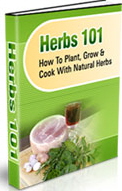Basil
 Basil is a fantastic herb used in a variety of dishes. Fresh basil is much different from the dried varieties, and adds not only flavor, but health benefits that only fresh herbs can provide.
Basil is a fantastic herb used in a variety of dishes. Fresh basil is much different from the dried varieties, and adds not only flavor, but health benefits that only fresh herbs can provide.
The health benefits of basil include both improving food quality and adding beneficial nutrients to your body. Basil has a natural antibacterial property that helps inhibit bacterial growth when it is added to food. Basil also contains vitamin A, anti-inflammatory properties, and flavonoids. All of these elements are greatly enhanced by using fresh, home-grown organic basil.
Planting Basil
The first step in planting basil is to select the variety you would like to grow. You may visit a store that has live basil plants and smell different varieties to see what is right for you.
Once you have selected your variety, growing basil is relatively easy. Basil likes lots of sun, well-drained soil, and plenty of water. You may plant your basil in a well-tilled garden area or a pot, whichever you prefer. Make sure you allow for 1 foot clearance on all sides of your plant.
Growing Basil
Growing herbs is much different from growing flowers or other houseplants. The goal of herb gardening is to cultivate a plant that provides the best tasting herbs, not the largest or most impressive foliage. Smaller and more dense plants will create more complex flavors, which are more suitable for cooking.
Basil is also a hearty plant that can grow under a variety of conditions. In general, the plants do not require plant food or fertilizer. Regular watering should be all that is needed for lush, healthy plants. Basil started in spring or early summer should be ready to harvest in a few months.
Basil may also be grown year-round using indoor growing techniques in the winter. It is a fairly simple process to grow basil indoors, and follows many of the same techniques used for outdoor gardening.
If you would like to transfer your basil plants indoors at the end of the outdoor growing season, simply follow these steps:
- Transfer the plant to a large enough pot for the size of our plant
- Prune off dead or unhealthy looking leaves and branches
- Wash the plant to remove insects or larvae that attached to the plant while it was outdoors
- Find a spot with plenty of light, but not in a cold draft, to grow your plant
- Water regularly
Harvesting Basil
Harvesting basil leaves for cooking is a simple process. Find the longest branches on your plant, and clip these branches half way to the stalk. This will give you the basil plants you need, but also ensure the overall health of the remaining plant. Harvesting in this manner will keep a vibrant and healthy plant that will provide basil to the end of the growing season.
It is very likely that 3 to 4 basil plants will produce more leaves than you can use at once. However, many herb gardeners choose to preserve the leaves for later use. The two most popular methods for preservation of herbs are freezing and drying. One popular method to dry leaves is using the oven. This provides for fast drying, and prevents damage due to excess moisture in the process. Freezing is another method, which tends to preserve more flavor. To freeze, simply wash the leaves and place them in a sealed plastic bag. Leaves can be stored for 4 to 6 months in the freezer using this process.
Further reading click here.
For Basil recipes click here.

